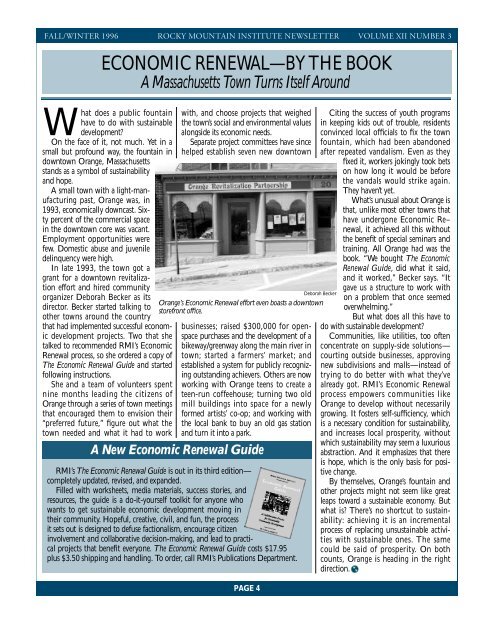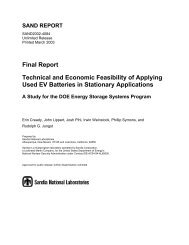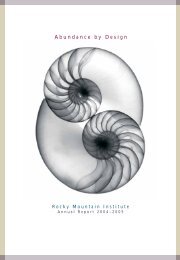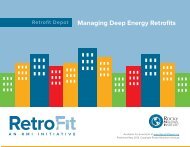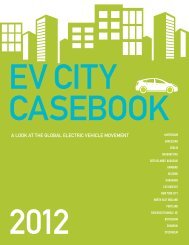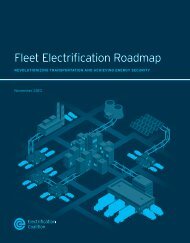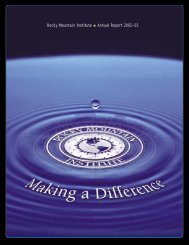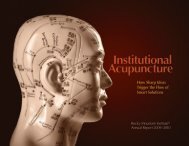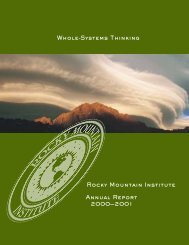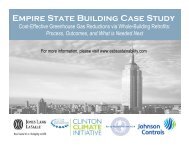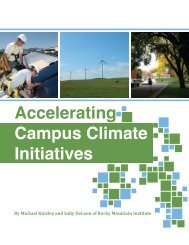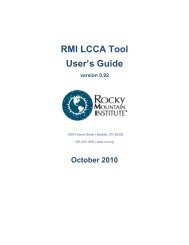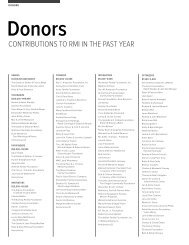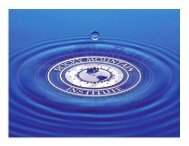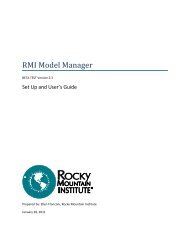FALL/WINTER 19<strong>96</strong> ROCKY MOUNTAIN INSTITUTE NEWSLETTER VOLUME XII NUMBER 3ECONOMIC RENEWAL—BY THE BOOKA Massachusetts Town Tu rns Itself Aro u n dWhat does a public fountainh a ve to do with sustainabled e ve l o p m e n t ?On the face of it, not much. Yet in asmall but profound way, the fountain ind ow n t own Orange, Ma s s a c h u s e t t sstands as a symbol of sustainabilityand hope.A small town with a light-manufacturingpast, Orange was, in1993, economically downcast. Si x-ty percent of the commercial spacein the dow n t own core was va c a n t .Em p l oyment opportunities we ref ew. Domestic abuse and juve n i l edelinquency we re high.In late 1993, the town got agrant for a dow n t own re v i t a l i z a-tion effort and hired communityo r g a n i zer Deborah Becker as itsd i re c t o r. Becker started talking toother towns around the countrythat had implemented successful economicdevelopment projects. Two that shetalked to recommended <strong>RMI</strong>’s Ec o n o m i cRe n ewal process, so she ord e red a copy ofThe Economic Renewal Gu i d e and start e df o l l owing instru c t i o n s .She and a team of volunteers spentnine months leading the citizens ofOrange through a series of town meetingsthat encouraged them to envision their“p re f e r red future,” fig u re out what thet own needed and what it had to workwith, and choose projects that we i g h e dthe tow n’s social and environmental va l u e salongside its economic needs.Separate project committees have sincehelped establish seven new dow n t ow nOrange’s Economic Renewal effort even boasts a downtownstorefront office.businesses; raised $300,000 for openspacepurchases and the development of ab i k ew a y / g reenway along the main river int own; started a farmers’ market; andestablished a system for publicly re c o g n i z-ing outstanding achievers. Others are noww o rking with Orange teens to create at e e n - run coffeehouse; turning two oldmill buildings into space for a new l yformed art i s t s’ co-op; and working withthe local bank to buy an old gas stationand turn it into a park .A New Economic Renewal Gu i d eR M I ’s The Economic Renewal Gu i d eis out in its third edition—completely updated, revised, and expanded.Filled with worksheets, media materials, success stories, andre s o u rces, the guide is a do-it-yourself toolkit for anyone whowants to get sustainable economic development moving intheir community. Hopeful, cre a t i ve, civil, and fun, the pro c e s sit sets out is designed to defuse factionalism, encourage citize ni n vo l vement and collaborative decision-making, and lead to practicalprojects that benefit eve ryone. The Economic Renewal Guide costs $17.95plus $3.50 shipping and handling. To ord e r, call <strong>RMI</strong>’s Publications De p a rtment.PAGE 4Citing the success of youth pro g r a m sin keeping kids out of trouble, re s i d e n t sconvinced local officials to fix the tow nfountain, which had been abandonedafter repeated vandalism. Even as theyfixed it, workers jokingly took betson how long it would be beforethe vandals would strike again.They have n’t ye t .W h a t’s unusual about Orange isthat, unlike most other towns thath a ve undergone Economic Re –n ewal, it achieved all this withoutthe benefit of special seminars andtraining. All Orange had was thebook. “We bought The Ec o n o m i cRenewal Gu i d e, did what it said,and it worked,” Becker says. “Itg a ve us a stru c t u re to work withon a problem that once seemedove rw h e l m i n g . ”But what does all this have todo with sustainable deve l o p m e n t ?Communities, like utilities, too oftenconcentrate on supply-side solutions—c o u rting outside businesses, approv i n gn ew subdivisions and malls—instead oft rying to do better with what they’vea l ready got. <strong>RMI</strong>’s Economic Re n ew a lp rocess empowers communities likeOrange to develop without necessarilyg rowing. It fosters self-suffic i e n c y, whichis a necessary condition for sustainability,and increases local pro s p e r i t y, withoutwhich sustainability may seem a luxuriousabstraction. And it emphasizes that thereis hope, which is the only basis for positi ve change.By themselves, Or a n g e’s fountain andother projects might not seem like gre a tleaps tow a rd a sustainable economy. Bu twhat is? There’s no shortcut to sustainability:achieving it is an incre m e n t a lp rocess of replacing unsustainable activitieswith sustainable ones. The samecould be said of pro s p e r i t y. On bothcounts, Orange is heading in the rightd i re c t i o n .Deborah Becker
FALL/WINTER 19<strong>96</strong> ROCKY MOUNTAIN INSTITUTE NEWSLETTER VOLUME XII NUMBER 3Ask R M I“Ask <strong>RMI</strong>” is a new regular feature wherewe’ll be answering re a d e r s’ questions one ve rything to do with re s o u rc e - e f ficient technologies,re s o u rce policy, and <strong>RMI</strong>’s re s e a rch.We’re priming the pump this time with acouple of questions we hear a lot, but fro mn ow on we’ll take your questions. Due tospace constraints, we’ll be able to answer onlyone or two questions per newsletter. Qu e s-tions with the broadest interest will be give np re f e rence. Sorry, we are unable to re s p o n dto individual letters for this column.Check out our new Frequently As k e dQuestions page, scheduled to be posted to ourWeb site (http://www. rmi.org) by 1 Ja n u a ry.Should I buy a rechargable battery pack?You pay a lot for the convenience ofbatteries: the cost of a kilowatt-hour ofelectricity from an alkaline D-cell isa round $127, and from an AA it’s $530!Non-alkaline batteries work out to bee ven more expensive. Since the sameamount of electricity from the grid onlycosts about 8 cents, it’s obviously moreeconomical to plug your gadgets into asocket whenever possible.But if you need portable powe r,rechargeable batteries can definitely savemoney and re s o u rces. Unlike disposables,they last for several hundred discharge/recharge cycles, and cost only pennies torecharge. Recharging allows you to getvastly greater use out of the battery’s“embodied energy” (the amount of energythat went into making it).A rechargeable setup costs more upfront. A multi-battery charger will ru n$30–60, and a selection of re c h a r g e a b l ebatteries (two each of AA, C, and D) willadd another $30. But even if you onlybuy a couple of disposable batteries amonth, your investment will pay for itselfin 18 to 28 months, and yo u’ll save about$38 a year there a f t e r.The better rechargers can accommodateall battery sizes, typically chargef a s t e r, and have smart chips to pre ve n tove rcharging. Solar rechargers are inexpe n s i ve and cost nothing to run, but theycharge slowly and work best in full sun( e ven haze will limit charging).Rechargeable batteries are n’t enviro n-mentally perfect. Most are “n i c a d s” (nickel-cadmium),which must be re c yc l e d— t h rowing them away will cause moree n v i ronmental harm than using disposables.(Call 800/8-BATT E RY to findyour nearest nicad re c ycling center.) Newernickel-metal-hydride or lithiumrechargeables, available from Real Go o d sand others, are almost nontox i c .Note that nicads last only a third aslong as single-use alkalines before needingto be recharged, and lose 1 percent oftheir charge per day even when they’re notbeing used, so they’re not suitable forsmoke detectors or emergency uses.When can I buy a hyperc a r ?We believe that early hypercars coulds t a rt appearing within about four ye a r s .Light battery-electric vehicles like GM’stwo-seat EV-1 (in production for re l e a s ethis December), Ho n d a’s four-seat EV(1997), and So l e c t r i a’s all-composite fourseatSunrise (1998) are two-thirds of theway there—they have light, aero d y n a m i cbodies and electric propulsion. Replace theheavy batteries with a small engine, generato r, and buffer storage device and yo u’vegot a functional hyperc a r. Adapting anexisting battery-electric vehicle would stilli n vo l ve many technical hurd l e s — d e ve l o p-Re c ycling containers saves energy, butre u s i n gthem saves more. It takes about7,000 BT Us to manufacture an aluminumcan from scratch, and 2,550 tomake it from metal re c ycled many times,losing some each time—but reusing abottle 10 times re q u i res only 610 BT Usper use. (A BTU is roughly the amountof energy in a kitchen match.)Sa ved energy is only one of seve r a lb e n e fits of deposit/return beverage systems,<strong>RMI</strong> re s e a rcher Scott Chaplinnoted in a speech this summer at No rt hCan We Can the Ca n ?ment and testing would take at least anextra year—but it would be easier thanbuilding a hypercar from scratch.We can’t comment on whether specificm a n u f a c t u rers are planning to do this, butwe wouldn’t be surprised to see this sort ofm o d i fied battery-electric vehicle offic i a l l ycome on the market around 2000. Howeve r, such first-generation hyperc a r swould be manufactured in small vo l u m e s ,and hence would be re l a t i vely expensiveand not widely available. They’d pro b a b l yappeal more to “early adopters” than tothe average motorist.But affordable, pro d u c t i o n - vo l u m eh y p e rcars are likely to appear ratherquickly there a f t e r. In d u s t ry / g ove r n m e n tcollaborations, foreign competition, andflexible re g u l a t o ry incentives are compellingAmerica’s Big Three to conve r g et ow a rd production hypercars—some ofthem aggre s s i ve l y. Within one or twodecades, we could see a diverse range ofquite re fined hypercars incorporating allad vanced-composite bodies and pro b a b l yfuel cells.While these are just rough estimates,we can say with confidence that automakershave strong incentive s — c h i e fly pro fitand market share—to move ve ry quickly.If yo u’re looking to improve your mileagein the meantime, you can choose fro mamong several conventional cars on them a rket that get better than 40 mpg.A m e r i c a’s first Reuse Conference inTo ro n t o.It so happens that Ontario, whosere c ycling council sponsored the conference,has one of the world’s bestd e p o s i t / return systems; nine out of 10beer containers are reusable bottles,which are used on average 15–20 times.In the United States, where only a fewstates have deposit systems, most softdrinks and beer are sold in aluminumcans, and only thre e - fifths of those arere c ycled.PAGE 5


